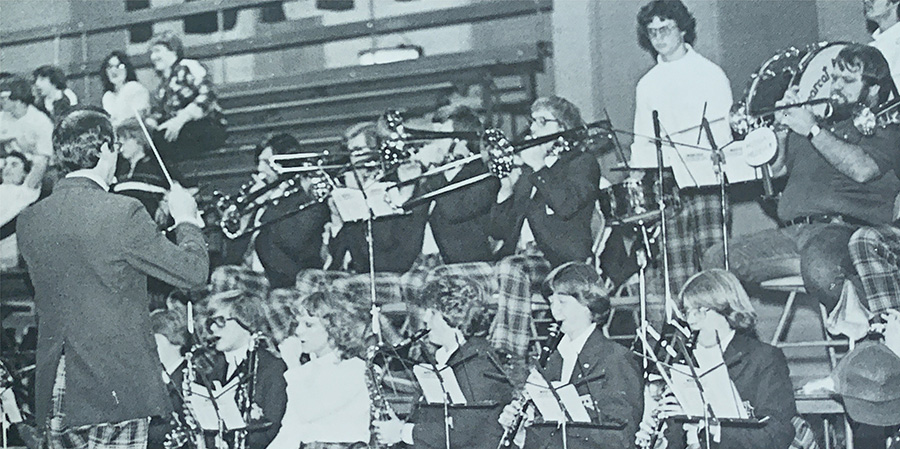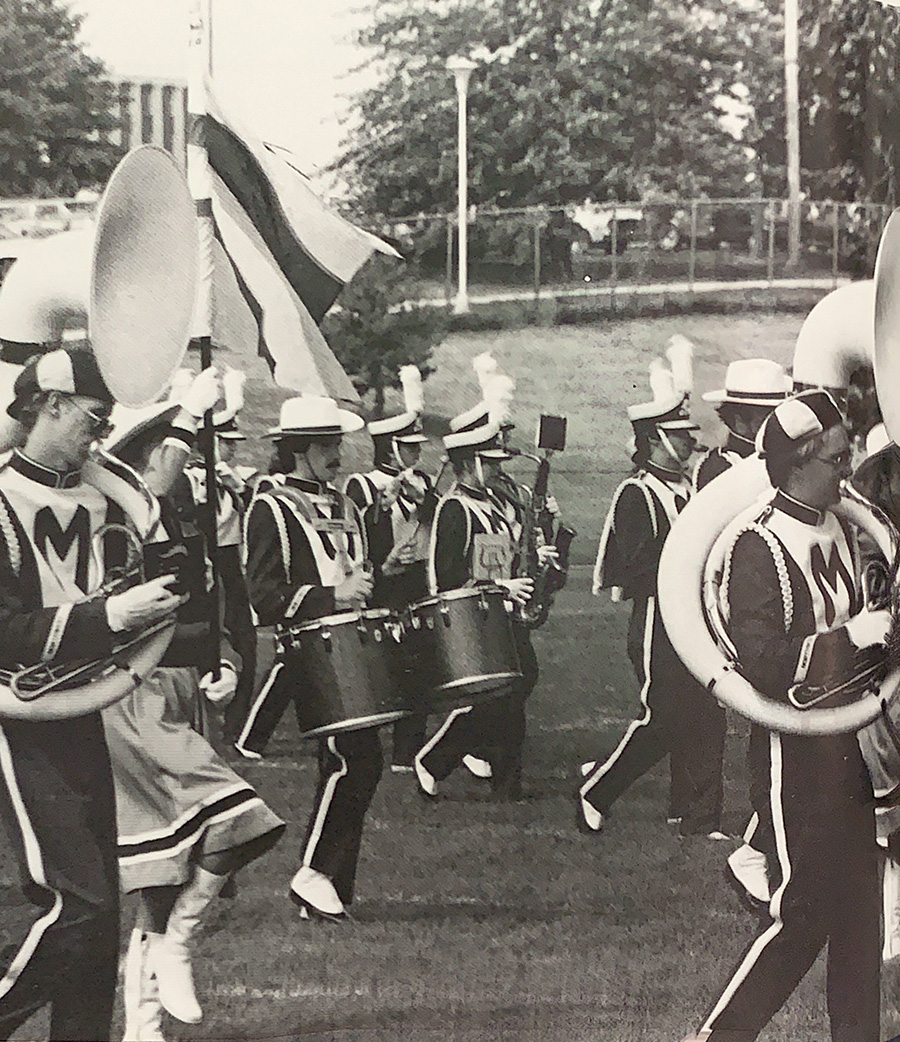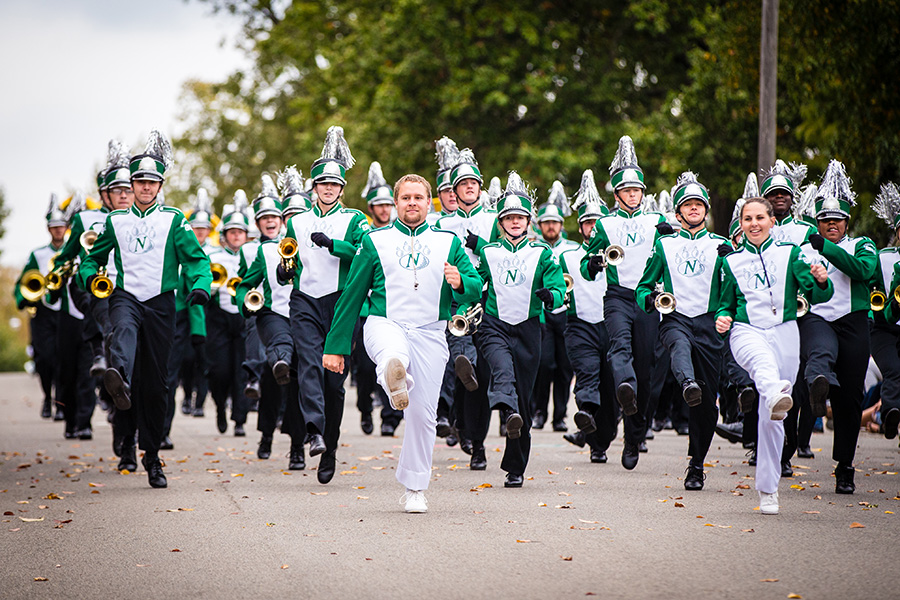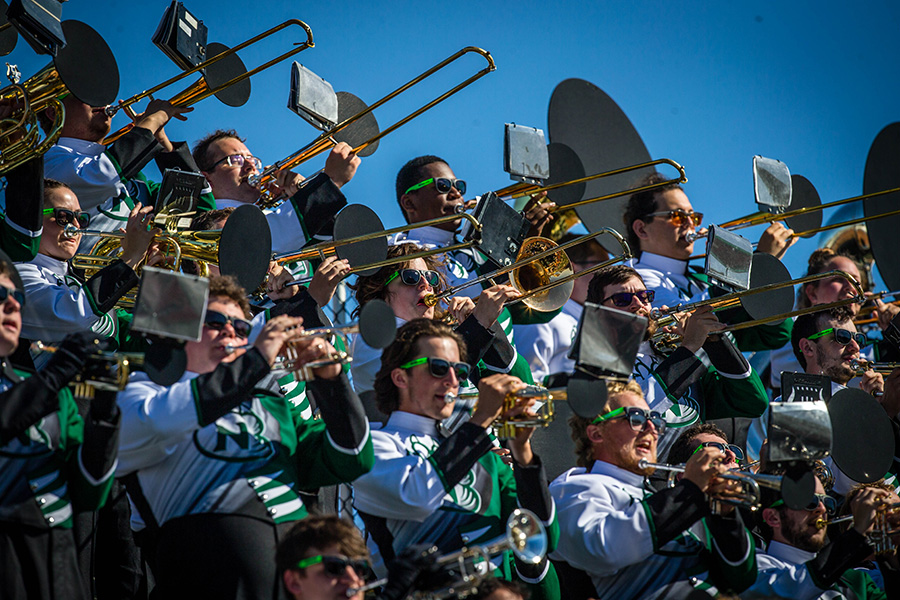Think of any joyous moment in the recent history of Bearcat athletics at Northwest Missouri State University. Picture the sight of the team hoisting another national championship trophy. Listen for the crowd clapping and cheering. You might hear the sound of the Bearcat Marching Band playing the “Bearcat Fight Song” in that moment, too.
It’s easy to think Northwest claimed the tune as its fight song not long after the University was founded in 1905 as the Fifth District Normal School, or after it adopted “Bearcats” as its nickname, thanks to an opposing coach in 1916.
In truth, the song has echoed across campus for barely a third of the institution’s existence.
“There are few people that remember anything else,” said Dr. Ernest Woodruff, who retired in 2012 as chair of the music department and served briefly as an assistant director of the Bearcat Marching Band after joining the Northwest music faculty in 1976. “Like any other schools and their traditions, they grow and grow. It begins to feel like that’s just the way it’s always been.”
Northwest had tried school songs throughout its first 50 years, but none of them stuck. A student campaign to select a fight song during the 1952-53 academic year never materialized, based on a review of University archives.
For years until 1978, the Bearcat Marching Band had performed pop songs and popular marches without a reliable fight song. A 1976 recording of a Bearcat Marching Band concert has the ensemble playing an array of pop songs as well as two Northwest mainstays – “Alma Mater” and the “Star-Spangled Banner.” That concert also featured the band playing “Go-Go Drums, Fight,” a recognizable tune that is better known as part of the University of Michigan’s fight song, “The Victors.”
Meanwhile, down in Texas, Dr. Terry Milligan had spent six years teaching sixth grade through high school, including four years at Permian High School in Odessa, and he was eager to teach at the university level. After completing his Doctoral of Musical Arts at the University of Texas, he was ready to move during the summer of 1978.
“I was applying for schools and Northwest was an outstanding, medium-sized school,” Milligan said. “And I thought, ‘Well, this would be a great place.’ So I applied at Northwest and ended up being there.”
When Milligan arrived at the University in the fall to conduct the Bearcat Marching Band, he quickly realized it didn’t have a fight song that it played consistently to rev up crowds at pep rallies or when Bearcat teams triumphed.
“I thought, ‘Well, Northwest should have its own thing,’” Milligan said. “Because there’s so many places, so many schools, that copy Michigan, Ohio State, Wisconsin and so on. I had become familiar with ‘Wings of Victory,’ the march in Odessa at Permian, and it just seemed like the trio for that march would be a good fight song or something good to play. One thing led to another, and the crowd liked it and the band liked playing it.”
American march music commonly consists of three strains, including the trio section that provides a resolution to the composition. “Wings of Victory” is a World War II-era march, composed by Frank Ventre, and Milligan installed its trio in the Bearcat Marching Band’s program without anticipating how crowds would react.
“It was kind of like a secondary song, and we ended up playing that more than we played the one that came from Michigan,” Milligan said. “It stuck.”
He added, “It was at football games and at pep rallies and, well, the crowds, they didn’t know what was going on to start with. But then they began to respond by clapping along with the march and so on. And one thing led to another.”

Dr. Terry Milligan conducts the Northwest pep band at a Bearcat basketball game during the 1978-79 school year. (1979 Tower yearbook)
Milligan, however, was a member of Northwest’s music faculty for just one year. During the spring of 1979, he received a phone call from one of his mentors who strongly encouraged him to apply for an opening at the University of Cincinnati College-Conservatory of Music. Milligan had intended to stay longer at Northwest and was reluctant to leave Maryville so soon, but he accepted the opportunity to continue his career in Cincinnati. He retired there in 2018 after 50 years of teaching music.
“I really enjoyed teaching at Northwest,” Millgan said. “The people, the students, the community, everything about that school and that town in Maryville is wonderful. I enjoyed it very much.”
In Milligan’s absence, Northwest appointed Guy D’Aurelio to conduct the Bearcat Marching Band. Then, Al Sergel arrived in the fall of 1981 and led the Bearcat Marching Band to a heightened source of pride at the University. Sergel, like Milligan, came to Northwest from Texas after more than a decade of teaching at the high school level. He quickly took notice of the fight song’s popularity and, in his 23 years conducting the Bearcat Marching Band, never considered removing or altering it.
“It had been played with Terry, and it had been covered in two years, and I’m walking in and I’ve done my 11 years of teaching in high school and I’m with a college band. I’m going, ‘I’m not making big changes.’”
As Sergel recalls, a conversation about the song’s status at Northwest eventually occurred with staff in the University’s marketing and communication office.
“It was really from the PR office and those guys said, ‘Is this our fight song?’ And I said, ‘I’m not sure, but this is what I was told by the kids. This is what I know about it.’ And I said, ‘I don’t plan to change it.’”
While Sergel didn’t change the composition, some additions to the song during subsequent years further cemented its distinction as Northwest’s fight song. Sergel doesn’t remember the year but recalls the cheerleading squad adding the now ubiquitous chant to the song’s finale and leading the crowd in the spelling of B-E-A-R-C-A-T-S. Years later, “Bearcats, Bearcats, go, Bearcats” was added to the chant.
“I know that there wasn’t any words when I first did it,” Sergel said. “There wasn't anything.”
That’s where Larry Cain, Northwest’s sports information director, and Tom Myers, the University’s news and information director, entered the fight song’s history. Like Sergel, Cain also noticed the song’s popularity among fans.
“They clapped along with it as people do to the fight song, they stood while it was played, and by the time I got there in 1980, it was fully accepted as just the fight song. … Everybody else assumed it had been around for 60 years or something. So it really evidently caught on very quickly.”

The Bearcat Marching Band performs at halftime of a Northwest football game in 1984. (1985 Tower yearbook)
In the fall of 1984, Cain was entering his fifth football season and tackling his annual responsibility of compiling the football program.
“I had noticed other schools and other programs were including lyrics of the fight song and of the alma mater in the program,” he said. “And I thought, ‘You know, that’s not a bad idea. We should put that in there. I mean, it’s not like people sing along with either one of them, but at least they’re there if people want to.’”
Cain had no trouble locating the lyrics of Northwest’s “Alma Mater,” which are printed regularly in commencement programs, University history books and other publications. But finding any lyrics to the fight song proved to be impossible. He estimates he spent two weeks paging through newspaper archives, Tower yearbooks and other materials in search of the fight song’s lyrics. Cain was out of ideas when he and Myers were conversing in their Administration Building office one day.
“I said, ‘You don’t, by any chance, have any idea what the lyrics of that fight song are, do you?’” Cain recalled. “Well, he didn’t either, and I can’t remember whether he said to me or I said to him, ‘Why don’t we just make up some lyrics, and do it that way?’ So we sat there and, line by line, I’d throw in a line and he’d throw one in, and in about 15 minutes we had the new, updated, revised, for-the-first-time-ever lyrics to ‘Wings of Victory.’”
The lyrics made their way into the football program for Northwest’s home opener against Washburn University that fall. Still, Cain held doubt about whether other lyrics existed for the song and expected to receive phone calls on the Monday morning after the Saturday football game to correct him.
“If somebody had done that, I would’ve said, ‘Fine, we’ll put those in the next program and go with them.’ Nobody ever did. I was at Northwest 11 more years. Those lyrics appeared in every football program between 1984 and 1995, and nobody ever said a word about them. … I imagine what happened was people looked, ‘Oh, so that’s what (the lyrics are).’ They were fine with it, evidently.”

The Bearcat Marching Band performs in Northwest's 2017 Homecoming parade. (Photo by Todd Weddle/Northwest Missouri State University)
Sergel retired in 2004 but came out of retirement in 2012 to direct the Bearcat Marching Band for one more season. In 2013, Dr. Katy Strickland arrived at Northwest after 13 years of teaching in Louisiana public schools and ushered in a new era of the marching band. Now, with Northwest alumni crossing the globe and numerous national championships to its name, “Wings of Victory” has become synonymous with the University.
“What was funny about it, and Katy still does it today, in order for the kids to know you want to play it, you just get your hand up and act like you got wings, wave your fingers, and they know you’re going to play the fight song,” Sergel said.
Strickland said, “What I connect the fight song with in my mind as the director of the marching band and the basketball pep band is just some unbelievable moments of celebration. That’s the first thing we play whenever something really great happens. So it's a moment of like the best kind of chaos there ever can be.”
“Everybody's losing their mind,” Strickland said. “The place is screaming. The kids are screaming. They’re jumping up and down, and we’re trying to get their attention. The drum majors trying to get their attention are jumping up and down, and so you end up just taking that energy and – it’s going to sound really kind of corny – but it ends up coming out the end of your horn, like just pride in your school.”

The Bearcat Marching Band performs at a 2021 Northwest football game. (Photo by Todd Weddle/Northwest Missouri State University)
Though the Bearcat Marching Band might make it look and sound easy, the composition of the song is not so.
“One of the things that wasn’t necessarily easy for the marching band were the upper woodwind parts,” Sergel said. “The clarinets have got some parts to play, and they’re extended. They’re scale runs, but boy, that’s not typical in a fight song. … And the trumpet parts are up pretty high, too. So if you’ve gotta play it a lot of times, you’re gonna get pooped out.”
Strickland added, “It’s different in that it’s got a section in the middle of it where most of the band stops playing and they chant, ‘Come on Bearcats fight, on to victory, hail the green and white, best in history’ and they just get into it. … It’s really nice that the B-E-A-R-C-A-T-S fits into the music very well.”
No matter the difficulty, Sergel and Strickland say band members always enjoy playing it and take pride in performing it well.
“You could talk to any of my band students – those that are out teaching, those kids that played in the band – they knew that there were three pieces of music that we had to play well and play consistently well because they were our voice,” Sergel said. “One is your fight song. The other’s your alma mater. And the third one’s the national anthem.”
Sergel added, “It’s a good time and a bad time song, really. It’s a good time when you’ve scored and you’ve done all those things and you’re winning. It really represents that we’re a part of it. When you’re not, it’s also something of a reminder that we are the school who we are and what we support. … That fight song will bring people back to the game. Or it’ll bring it back to know that ‘Okay, maybe we’re gonna lose one, but we’ll be back.’”
Strickland concluded, “When you start playing it for the first time at band camp, everybody’s excited to kind of get back to the thing. They like it. As much as we play it, they never get sick of it. … I guess that’s because it’s accompanied by a whole lot of fun. You never play the fight song when you’re not having fun.”
Milligan says he’s humbled that the fight song gained popularity and it’s still being played at Northwest.
“I didn’t necessarily expect that to happen, but it did,” he said. “When we would play a pep band at a basketball game, it was a popular and enjoyable thing for us to be doing. So I suspected something was afoot, so to speak, and like I said, I’m delighted that it’s still there and it has continued, and that Northwest now has its own fight song.”